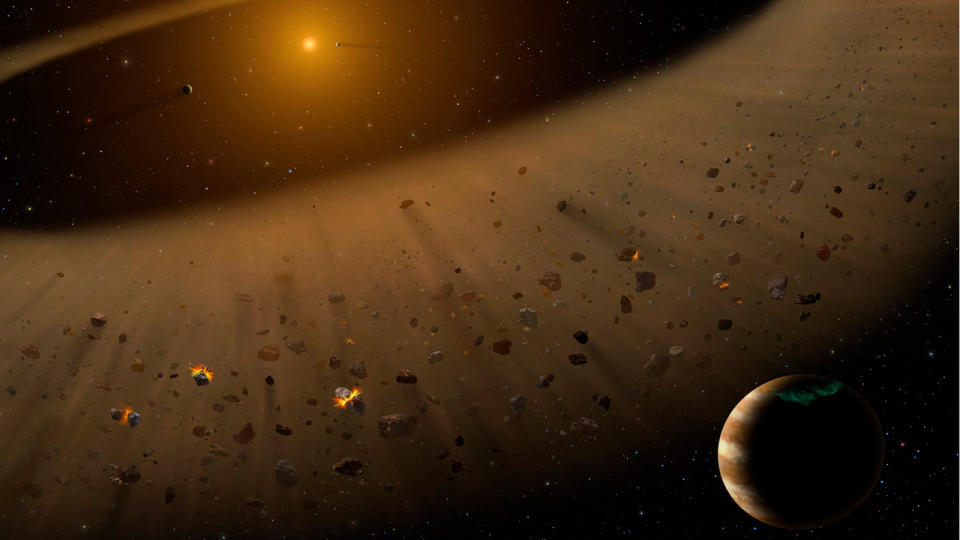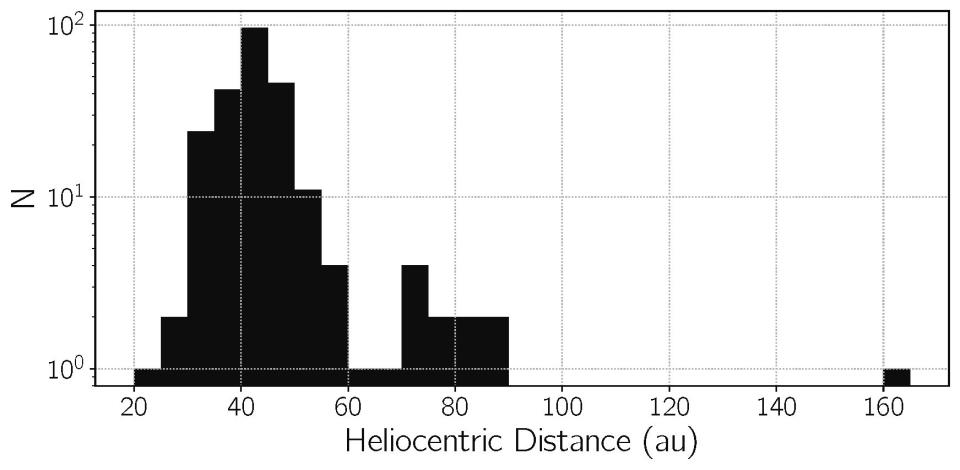When you buy through links on our articles, Future and its syndication partners may earn a commission.


A brand-new group of frozen objects, orbiting the sun out beyond the distant Kuiper Belt, has been spotted by the Subaru telescope, working with NASA‘s New Horizons mission to find new targets for the spacecraft to investigate.
If this is confirmed, it would be a major discovery,” said Fumi Yoshida, from the University of Occupational and Environmental Health Sciences and the Planetary Exploration Research Center, Chiba Institute of Technology, in a statement.
Subaru, which is an 8-meter (26-foot) telescope atop Mauna Kea in Hawaii, has been working with New Horizons since its 2006 launch toward Pluto, which the spacecraft flew by in 2015. Since then, New Horizons has been blazing a trail through the Kuiper Belt, which is a ring-shaped region of icy cometary bodies beyond the orbit of Neptune at distances between 33 and 55 astronomical units (AU). An astronomical unit is equivalent to Earth‘s average distance from the sun, which is 149.6 million kilometers (93 million miles).
When Subaru began searching for Kuiper Belt objects in 2004 as potential targets for New Horizons to either visit up close or to watch with its cameras from a distance after encountering Pluto, the telescope was faced with a problem. At the time, Pluto and the area of the outer solar system to which New Horizons was headed was in the constellation of Sagittarius, which has the dense center of the Milky Way as a backdrop, making it hard to pick out Kuiper Belt objects from all the background stars. At the time, Subaru identified just 24 Kuiper Belt objects, all of which were too far away for New Horizons to reach or view with its cameras after leaving Pluto. (Arrokoth, a Kuiper Belt object that New Horizons visited on New Years’ Day 2019, was found by the Hubble Space Telescope.)
Related: What is the Kuiper Belt?
Now, however, Pluto and that part of the solar system has moved away from the backdrop of the Milky Way into a sparser region of the night sky. With its Hyper Suprime-Cam (HSC), Subaru has discovered 239 Kuiper Belt objects since 2020. Most of these are regular Kuiper Belt objects, but a smattering seem to be very special indeed.
“The most exciting part of the HSC was the discovery of 11 objects at distances beyond the known Kuiper Belt,” said Yoshida.
This new group of objects isn’t a mere extension of the Kuiper Belt. There appears to be a gap between 55 AU and 70 AU where no objects have yet been found, and then a second belt — let’s call it “Kuiper Belt 2” — between 70 and 90 AU, which is as far out as 13.5 billion kilometers (8.4 billion miles) from the sun. For comparison, Neptune lies at 30 AU and New Horizons is currently 60 AU from the sun, while NASA’s Voyager 1 and Voyager 2 probes are 164.7 and 137.6 AU from the sun, respectively — out in interstellar space.
Related: Solar system planets, order and formation: The ultimate guide


The architecture of the solar system, including the asteroid belt and the Kuiper Belt, was determined by the processes that formed the planets, including how the young Jupiter migrated through the system, scattering smaller bodies far and wide.
“I think the discovery of distant objects and the determination of their orbital distribution are important as a stepping stone to understanding the formation history of the solar system, comparing it with exoplanetary systems, and understanding universal planet formation,” said Yoshida.
The discovery of this new population of bodies is not entirely out of the blue. The Student Dust Counter instrument on board New Horizons keeps detecting impacts from dust particles, though the rate of impacts should be decreasing as New Horizons departs the Kuiper Belt. The continued presence of dust suggests that it is being produced by a population of bodies farther out. In addition, New Horizons has witnessed unexplained stellar occultations — when an object passes in front of and briefly blocks the light of a distant star — that could be the product of objects in this newly discovered, more distant ‘Kuiper Belt 2.’
Furthermore, observations of protoplanetary disks around other stars, such as those seen by ALMA, the Atacama Large Millimeter/submillimeter Array in Chile, clearly show extended regions and numerous belts and gaps in the region beyond where the Kuiper Belt is in our solar system.
“Our solar system’s Kuiper Belt long appeared to be very small in comparison with many other planetary systems, but our results suggest that idea might just have arisen due to an observational bias,” said Wes Fraser of the National Research Council of Canada, who led the new findings. “So maybe, if this result is confirmed, our Kuiper Belt isn’t all that small and unusual after all compared to those around other stars.”
Because the Kuiper Belt had seemed small, one theory had been that the solar nebula that formed our planetary system had also been smaller than normal. The discovery of this Kuiper Belt 2 suggests that was not necessarily the case.
“The primordial solar nebula was much larger than previously thought, and this may have implications for studying the planet formation process in our solar system,” said Yoshida.
RELATED STORIES:
— Our solar system map may need an update — the Kuiper belt could be way bigger
— What cosmic object ‘Arrokoth’ can tell us about our solar system’s formation
— Could an ‘Earth-like’ planet be hiding in our solar system’s outer reaches?
Astronomers will continue to use Subaru to track the 11 objects in this new belt to better define their orbits. Given they were found in a small region of space, they probably are only the tip of the iceberg and hint at a much larger population. Their discovery is further evidence that there is still much to be discovered in the extreme depths of the outer solar system, including the possibility of more dwarf planets and even the hypothesized Planet Nine.
“This is a groundbreaking discovery revealing something unexpected, new and exciting in the distant reaches of the solar system,” said Alan Stern, who is the principal investigator on the New Horizons mission. “This discovery probably would not have been possible without the world-class capabilities of the Subaru Observatory.”
The findings are set to be published in the Planetary Science Journal, and are currently available as a preprint.
